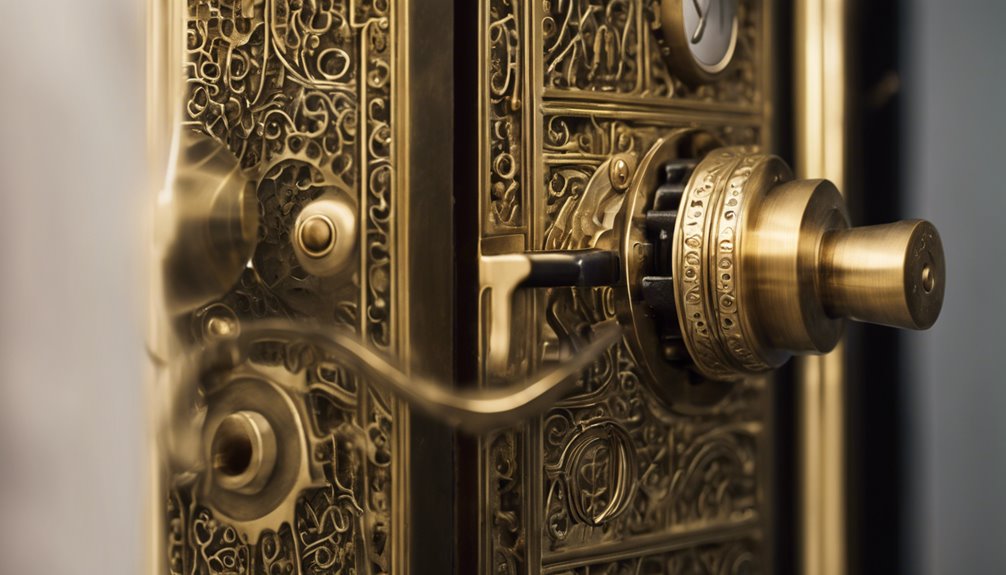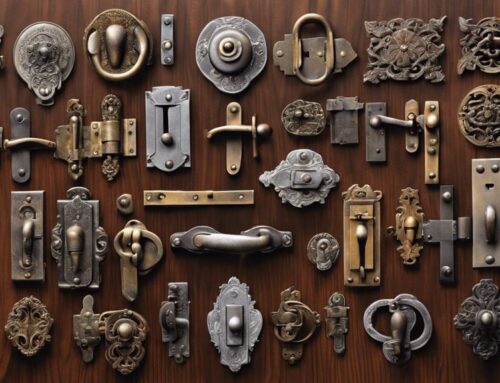When you consider the evolution of security, you can’t overlook Bramah Locks and Joseph Bramah’s revolutionary designs. Since 1784, these locks have combined artistry with practical engineering, setting standards for durability and innovation. By introducing features like the cylindrical key and sliding lever, Bramah challenged the norms of his time, ensuring that only the best craftsmanship protected valuable properties. Yet, as the story unfolds, you’ll discover not just the triumphs but also the challenges that shaped the brand’s legacy—something that continues to resonate in modern security solutions today.
Key Takeaways
- Founded in 1784 by Joseph Bramah, the company revolutionized locking mechanisms with innovative cylindrical keys for enhanced security.
- Bramah Locks introduced the sliding lever mechanism, utilizing interlocking levers for robust security and easy usability.
- Patented key designs and strict protocols minimize unauthorized duplication, ensuring superior security in various settings.
- The brand’s influence extends to modern smart locks, reflecting the integration of traditional craftsmanship with contemporary technology.
- Bramah Locks symbolize cultural significance in design, inspiring modern architecture while maintaining a balance between security and accessibility.
History of Bramah Locks

Although many innovations in security have come and gone, Bramah Locks remains a distinguished name in the field, thanks to its rich history that dates back to the late 18th century.
Founded by Joseph Bramah in 1784, the company revolutionized locking mechanisms by introducing the unique, cylindrical key that provided increased security against traditional lock-picking techniques. Additionally, the design of these locks significantly enhanced security measures when used in combination with deadbolts, further protecting against unauthorized access.
Bramah’s ingenuity not only set a new industry standard, but also led to several significant patents that underscored its commitment to innovation. The company’s high-security locks feature advanced mechanisms that make them more resistant to tampering, ensuring superior protection against unauthorized access.
The brand quickly gained renown, with its locks securing prestigious establishments and even Royal residences.
As you explore Bramah’s history, you’ll discover how this pioneering spirit paved the way for modern security solutions, highlighting the enduring legacy that still influences the industry today.
Key Features Explained

As you explore the innovative design of Bramah locks, you’ll notice the remarkable sliding lever mechanism that enhances security and ease of use. When considering replacements, it’s crucial to evaluate security upgrades that can improve overall safety. The incorporation of false notches prevents unauthorized access, showcasing a clever approach to lock engineering. Additionally, the unique key control system guarantees that only authorized users can duplicate keys, further solidifying its reputation for reliable security. This system is complemented by the use of lock pins and tumblers, which are essential components in preventing forced entry.
Sliding Lever Mechanism
The sliding lever mechanism, a pivotal innovation in the domain of locks, showcases several key features that enhance security and usability.
Designed for robustness, this mechanism uses a series of levers that interlock with corresponding pins in the lock body. When a correct key is inserted, it aligns these levers to a specific position, allowing the bolt to slide smoothly into the open position.
This precise alignment not only deters forced entry but also minimizes wear over time, ensuring durability. Additionally, the mechanism’s design allows for easy operation, giving you the confidence that your security is both effective and user-friendly. Furthermore, the combination of robust mechanical security with advanced locking mechanisms can mitigate the risks associated with electronic breaches. In addition, a well-chosen lock can significantly improve your home security levels, providing peace of mind for you and your family.
False Notches Design
Building on the innovative principles exemplified by the sliding lever mechanism, the false notches design introduces an additional layer of sophistication in lock security.
This design cleverly incorporates deceptive notches on the key, effectively enhancing the lock’s resistance to unauthorized access.
You’ll appreciate these key features:
- Deceptive Complexity: The notches create confusion, making it challenging for potential intruders to discern the correct positioning of the key.
- Enhanced Engagement: The false notches interact with the lock’s internal components, requiring precise alignment for successful engagement.
- Improved Theft Deterrence: Any attempt to manipulate the lock with a standard key is likely to fail, elevating the overall security. Additionally, re-keying locks is often a more cost-effective solution than complete replacements, ensuring continued security without substantial investment.
Furthermore, lock re-keying can be an effective additional security measure, allowing for the quick changing of lock access without replacement. This design guarantees only designated keys can operate the lock, reinforcing your control over access.
Unique Key Control
While guaranteeing your property remains secure, unique key control offers an advanced system that considerably minimizes the risk of unauthorized duplication. This sophisticated mechanism incorporates patented key designs and restricted duplication protocols that place tight reins on key issuance. Unlike conventional locks, Bramah’s system enables you to maintain a detailed record of who’s access, thereby enhancing accountability.
Additionally, the integration of signature cut keys ensures that only authorized locksmiths can reproduce copies, safeguarding your security framework from potential breaches. With unique key control, you establish a granular level of access management, allowing for specific permissions tailored to individual users. Moreover, it is vital to consider the importance of rekeying locks as part of your security strategy when facing potential key compromises. Regular re-keying processes in multi-unit spaces also significantly enhance security by minimizing risks associated with shared access.
This strategic approach not only fortifies your defenses but also enhances your overall operational security.
Security Innovations Over Time

As security needs evolved over centuries, innovations in locking mechanisms have continuously shaped our understanding of safety.
You’ll notice three pivotal advancements that markedly enhanced security:
- The Pin Tumbler Lock – Introduced in the 19th century, it revolutionized access control by using a series of pins that prevent unauthorized entry.
- The Deadbolt – This sturdy locking option offered increased resistance to force, becoming a staple in residential security.
- Smart Locks – Recently, smart technology has integrated connectivity, allowing remote access and monitoring, changing how you perceive security.
These innovations reflect an ongoing commitment to adapting to evolving threats, emphasizing the essential interplay between security design and user needs. Moreover, robust home security is crucial for peace of mind and asset protection.
Each advancement not only offers protection but also embodies the relentless quest for better safety solutions.
Challenges and Controversies

Although advancements in locking technology have greatly improved security, they’ve also introduced a host of challenges and controversies that complicate the implementation and effectiveness of these innovations.
One significant challenge lies in the balance between security and accessibility; as locks become more advanced, they can also become more difficult for legitimate users to operate. Moreover, high-security locks often feature advanced bolt strength that resists brute force attacks, which can complicate access for individuals not familiar with the specific locking mechanism.
Additionally, the rise of intelligent locks raises concerns about cybersecurity vulnerabilities; unauthorized access can occur remotely, undermining the integrity of the entire security system. This issue is compounded by the fact that many high-security locks are designed to withstand picking and bumping, making their effectiveness dependent on surrounding security measures.
Moreover, the cost associated with these cutting-edge locks often alienates smaller businesses or homeowners. The initial investment in high-security locks may deter potential users, despite offering long-term value through enhanced protection against theft.
Ethical considerations also emerge, as the proprietary technology can lead to monopolies and limited choices for consumers. This can result in a lack of readily available options for those seeking affordable yet secure solutions in everyday locking mechanisms.
Consequently, maneuvering through these complexities is essential for the successful adoption of modern locking solutions. Understanding the psychological factors that influence perceived security can also play a crucial role in how consumers evaluate these locking technologies.
Modern Legacy of Bramah Locks

The modern legacy of Bramah Locks extends beyond their historical significance, showcasing the role they play in today’s lock restoration services. You’ll find that these locks not only require careful handling but also serve as valuable educational tools that highlight advancements in security technology over time. Additionally, their designs have influenced the development of contemporary smart lock technology, demonstrating how traditional innovations continue to impact modern security solutions. Today, re-keying methods have evolved significantly, aligning with the needs of modern security practices that enhance user convenience and safety.
Lock Restoration Services
When considering the modern legacy of Bramah Locks, one can’t overlook the significance of lock restoration services in preserving the ingenuity and craftsmanship that these locks embody.
These services allow you to appreciate the historical value while ensuring functionality.
- Expert Assessment: Skilled technicians evaluate the lock’s condition, identifying necessary repairs and restorations.
- Historical Accuracy: Restoration prioritizes original materials and techniques, ensuring each piece retains its authenticity.
- Mechanical Performance: You’ll witness a seamless turn of the key and a reassuring click, revitalizing old mechanisms to modern standards.
Educational Tool Influence
Bramah Locks have not only stood the test of time as a security solution but also serve as an essential educational tool that enhances our understanding of historical craftsmanship in locking mechanisms. By studying these intricate devices, you’ll grasp the evolution of engineering techniques and materials. Their mechanisms illustrate key principles of design, security, and innovation.
| Key Concept | Educational Relevance |
|---|---|
| Mechanism Design | Understanding complexity in simplicity |
| Historical Context | Insights into 18th century engineering |
| Material Science | Evolution of durable materials |
| Security Principles | Foundation for modern security systems |
| Craftsmanship Skills | Rethinking hands-on skills in technology |
These attributes offer invaluable lessons, not just for historians, but for future innovators in security technology.
Cultural Impact and References

Although often overlooked, the influence of Bramah locks on culture and security practices can be observed in various aspects of contemporary life.
They’re not just about physical security; they’ve become symbols of ingenuity. You can see this reflected in:
- Literary References: Writers invoke Bramah locks to signify impenetrability and honor in narratives.
- Artwork: Various artists depict these locks as metaphors for protection, transformation, and trust.
- Modern Architecture: Innovative lock designs draw inspiration from Bramah’s principles, blending security with aesthetic appeal.
These elements underscore how deeply ingrained Bramah’s legacy is in our collective psyche, showcasing security’s role as both a necessity and a culturally significant concept, transcending mere functionality.
Preservation and Collecting

Collecting and preserving Bramah locks has become a niche yet fervent passion among enthusiasts and historians alike. This intricate craft requires an understanding of both the technical specifications and historical context behind each lock.
You’ll explore the different models, examining factors like materials used and locking mechanisms. Preservation often involves careful restoration, demanding knowledge of authentic materials and techniques to maintain integrity.
Documentation of provenance is critical; it adds depth to your collection and showcases its historical significance. Networking with fellow collectors not only enhances your expertise but also fosters collaboration on restoration efforts.
Influence on Contemporary Design

As innovations in security design evolve, the legacy of Bramah locks undeniably informs contemporary approaches to lock manufacturing.
You’ll find that modern designs often reflect Bramah’s principles through:
- Precision Engineering: Today’s locks utilize intricate mechanisms that mirror the meticulous craftsmanship established by Bramah.
- User-Centric Functionality: Modern locks are designed for ease of use, ensuring security doesn’t compromise accessibility, an ideal Bramah championed.
- Aesthetic Integration: Contemporary designs often combine form and function, just as Bramah locks did, ensuring they complement a variety of architectural styles.
Understanding these influences allows you to appreciate the intersection of tradition and innovation in today’s security solutions.
Each step forward builds on the profound foundation Bramah laid in the world of locking mechanisms.
Frequently Asked Questions
How Can I Identify an Original Bramah Lock?
To identify an original Bramah lock, examine the design closely.
Look for the distinctive round keyhole, often accompanied by intricate engravings on the body.
You’ll find a unique, numbered key that matches the lock, highlighting its authenticity.
Check for the manufacturer’s name or logo, typically engraved, which should be clear and precise.
Authentic locks are made from high-quality materials, so inspect the build for sturdiness and craftsmanship.
Where Can I Purchase Antique Bramah Locks?
If you’re looking to purchase antique Bramah locks, consider exploring specialized auction sites, antique shops, or online marketplaces like eBay and Etsy.
Attending estate sales and antique fairs can yield unique finds as well.
Don’t shy away from contacting locksmiths or collectors—they might’ve leads on authentic pieces.
It’s vital to verify the authenticity of each lock, so always ask for provenance and scrutinize details carefully before making a purchase.
What Maintenance Do Bramah Locks Require?
Maintaining your Bramah locks is essential; they can withstand the test of time better than any superhero!
Regularly lubricate the keyhole with graphite-based lubricant to guarantee smooth operation.
Inspect the lock for dirt or debris—clean it gently with a soft cloth.
If you notice any sticky movement, disassemble the parts for deeper cleaning.
Finally, check for wear and tear, replacing components as needed to uphold their legendary security.
You’re safeguarding history!
Are There Modern Equivalents to Bramah Locks?
Yes, there are modern equivalents to Bramah locks that offer similar durability and security features.
Many contemporary high-security locks incorporate advanced mechanisms, such as key control systems and anti-picking technology.
Brands like Medeco and Mul-T-Lock provide locks that rival the security offered by Bramah.
You should assess your security needs and compare features, ensuring your choice balances innovation with reliability, much like the original designs that set the standard for lock security.
How Do I Unlock a Stuck Bramah Lock?
Imagine your key’s on a relentless quest, battling a stubborn Bramah lock that’s too proud to yield.
To release it, start by applying graphite powder; it’s the secret weapon against stubbornness. Wiggle the key gently while you apply light pressure, coaxing it to cooperate.
If that fails, a few strategic taps on the lock’s side might do the trick. Just remember, patience is key—sometimes mastery requires a little finesse and humor.
Conclusion
To sum up, Bramah Locks isn’t just a brand; it’s a fortress of innovation that has withstood the test of time. Its pioneering designs and unwavering commitment to security have shaped not only locks but the very essence of safety itself. You can see how the echoes of its legacy resonate in modern security solutions, proving that even in a rapidly changing world, the brilliance of Bramah’s craftsmanship continues to stand like an unyielding bulwark against intrusion.






